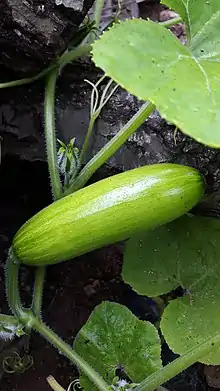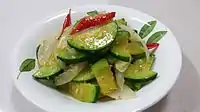| Aehobak | |
|---|---|
 Aehobak after rain | |
| Species | Cucurbita moschata |
| Cultivar |
|
| Origin | Korea |
| Korean name | |
| Hangul | 애호박 |
|---|---|
| Revised Romanization | aehobak |
| McCune–Reischauer | aehobak |
| IPA | [ɛ.ɦo.bak̚] |
Aehobak (Korean: 애호박), also called Korean zucchini or Korean courgette,[1][2] is an edible, green to yellow-green summer squash. Although nearly all summer squashes are varieties of Cucurbita pepo,[3] aehobak belongs to the species Cucurbita moschata.[4] Commonly used in Korean cuisine, an aehobak has the shape of zucchini, but with thinner, smoother skin, and more delicate flesh.[5] It is usually sold in shrink-wrapped plastic.[5]
Cultivars of Korean zucchini include 'Seoulmadi', 'Bulam-sacheol', and 'Miso'.[4][6][7]
Culinary use
In Korean cuisine, the squash is used either fresh or dried. Fresh aehobak can be pan-fried, either julienned in batter into buchimgae or sliced and egg-washed as jeon. It is often made into namul-banchan (seasoned vegetable side dish), usually seasoned with salted shrimps and stir-fried. Sometimes, aehobak features as the main ingredient in stew dishes such as jijimi and mureum. Dried aehobak, called hobak-goji, can be prepared by slicing the squash thinly and sun-drying the slices. It is soaked before cooking, then usually stir-fried to make a bokkeum or namul.
The squash is also used in royal court dishes such as seon, and more recently in wolgwa-chae, replacing the Oriental pickling melon.
 Sliced aehobak
Sliced aehobak.jpg.webp) Hobak-goji (dried aehobak)
Hobak-goji (dried aehobak) Aehobak-namul (stir-fried aehobak)
Aehobak-namul (stir-fried aehobak) Aehobak-gyeran-mari (rolled aehobak omelettes)
Aehobak-gyeran-mari (rolled aehobak omelettes) Aehobak-buchimgae (aehobak pancake)
Aehobak-buchimgae (aehobak pancake)
 Hobak-jeon (pan-fried aehobak)
Hobak-jeon (pan-fried aehobak) Hobak-seon (stuffed aehobak)
Hobak-seon (stuffed aehobak)
See also
- Oriental pickling melon – Group of nonsweet melon cultivars
- Straightneck squash – Type of summer squash that is usually yellow-colored
- Tromboncino – Cultivar of Cucurbita moschata.
- Zucchini – Edible summer squash
References
- ↑ Lee, Cecilia Hae-Jin (28 April 2015). "Where to find jeon, Korean flatcakes, in Los Angeles". Los Angeles Times. Retrieved 15 October 2016.
- ↑ Lethlean, John (11 December 2017). "Paper Bird comes up with its own yukhoebab". The Australian. Retrieved 12 February 2018.
- ↑ "Zucchetta". Mount Vernon Northwestern Washington Research and Extension Center. Washington State University. Retrieved 14 October 2016.
- 1 2 Hong, Kue Hyon; Om, Young Hyun; Ko, Kwan Dal; Heo, Yun Chan; Yoon, Jin Young (December 1997). "SHORT INFORMATION (Characteristics of New Varieties Developed in 1997): A New Semi-bush Type "Aehobag" (Elongated Squash for Picking at Green Mature Stage) Lines, 'Wonye #401' and 'Wonye #402'". Korean Journal of Breeding Science (in Korean). 29 (4): 509. Retrieved 15 October 2016.
- 1 2 Jung, Susan (9 September 2016). "Susan Jung's recipes for seared scallops". South China Morning Post. Retrieved 23 November 2016.
- ↑ Kim, Byung Hwan; Seo, Young Gi (May 1976). "Studies on the interspecific hybrids of Cucurbita species (II) – Breeding process and characteristics of Bulam Sacheol Aehobak". Journal of the Korean Society for Horticultural Science (in Korean). 17 (1): 38–46. Retrieved 20 October 2016.
- ↑ Cho, Myeong-Cheoul; Om, Young-Hyun; Huh, Yun-Chan; Cheong, Seung-Ryong; Kim, Dae-Hyun; Mok, Il-Gin (December 2011). "Breeding of Powdery Mildew Resistant Squash 'Miso'". Korean Journal of Organic Agriculture. 19 (5): 1–5. Retrieved 20 October 2016.
